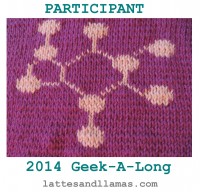One of my favorite heels for a toe-up sock is the Widdershins heel – which looks almost exactly like a cuff-down heel flap heel. My other favorite heel for a toe-up sock is Fleegle's – which looks almost like a short-row heel but isn't. By the way, widdershins means backwards, "in the opposite direction".
Here is a paraphrasing of the directions for the Widdershins heel:
Gusset increases: The first question in making the heel is when to start making gusset increases (to mirror gusset decreases for the usual cuff-down heel flap). The answer is:
- Figure out how long you want the heel flap. For an average cuff-down heel flap, one picks up 15 sts on each side of the heel flap – which means the heel flap itself has 30 rows.
- Start making gusset increases this number of rows before the end of the sock. So, for a 30-row heel flap, you'd start making gusset increases on every other round starting at 30 rows less than the total length of the sock.
- Divide the number of sole stitches by 9. Round down.
- Add 1.
- Double the result.
- Subtract this number from the number of rows for the heel flap.
For a sock with 62 sts around (31 instep sts and 31 sole sts), you would divide 31 by 9 and round down. The result is 3. Add 1 to get 4. Double it to get 8. Then subtract this from 30 to get 22. So, you'd make 11 pairs of gusset increases to arrive at 53 sole sts. ( 53 = 31 + 22)
Finish the bottom of the heel: After finishing the gusset increases, place markers to mark the sides of the heel flap. For this example of a 30 row heel flap, place markers 15 sts in from either side, leaving 23 sts between markers. The stitches between markers are called heel sts. The sts outside the markers are called gusset sts. Then, working only on the heel sts:
- Row 1: k to 2 sts before marker, inc1, k1, turn
- Row 2: s1, p to 2 sts before marker, inc1, p1, turn
- Row 3: s1, k to 2 sts before gap, inc1, k1, turn
- Row 4: s1, p to 2 sts before gap, inc1, p1, turn
Note: For a more rounded heel, replace “2 sts” in Rows 3 and 4 with “3 sts”. For an even more rounded heel, change it to “4 sts” or maybe even “5 sts” for the last repeat of the two rows.
Note: For a squarer heel, repeat Rows 1 and 2 until the number of sts between markers is the same as the original number of sole sts. (Do not do rows 3 and 4.)
Heel flap: Then start making the heel flap:
- Row 1: s1, k to last heel st, ssk last heel st and 1 st from left gusset, turn
- Row 2: s1, p to last heel st, p2tog last heel st and 1 st from right gusset, turn
The heel is now finished.


2 comments:
I LOVE this heel and have made many toe up socks with it. BUT, it has been a while since I have done it. I am having a hard time remembering how to do the "yarn over from front to back on right needle.." Is there anyone who has a video of how to do this heel for sale. I believe it would be well worth the money to "see" the way they bring the yarn forward on this heel. I have a gremlin that goes in my head at night and hits the ctrl alt del buttons. By the next morning, I can't remember anything. hahahaha Is it possible to do a video on this on YouTube? I vaguely remember that the yo for the purl side was a little strange...but vaguely is the key word here. Thanks so much for any assistance you can give me.
I love this heel as well.
Here's a video on "yarn over from front to back on right needle":
https://www.youtube.com/watch?v=WSF-D3sru90
Here's a tutorial including the purl side:
https://www.thespruce.com/yarn-overs-for-different-situations-2116519
When I work a Widdershins heel, I don't use that increase at all though. I usually do M1R on the RS and M1P (make 1 purl) on the WS. I've also used working a kfb on the RS and pfb on the WS.
Recently, I grown to know and love the lifted increase - which would work well here as well.
https://www.youtube.com/watch?v=VZ01r1hWGks
(On the WS of the work, one would purl the lifted stitch.)
Post a Comment